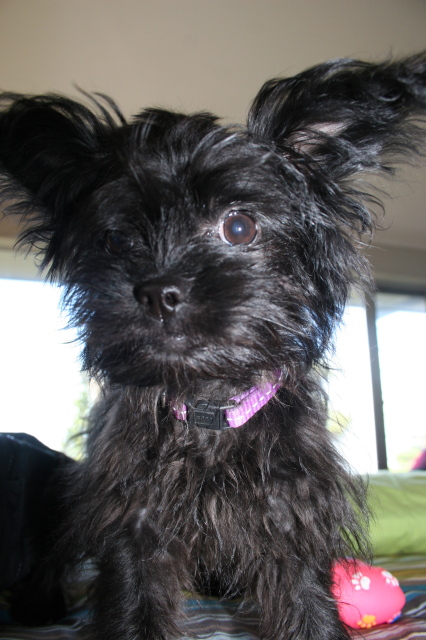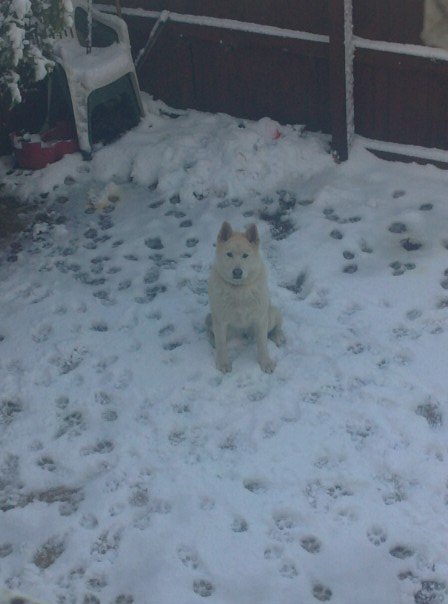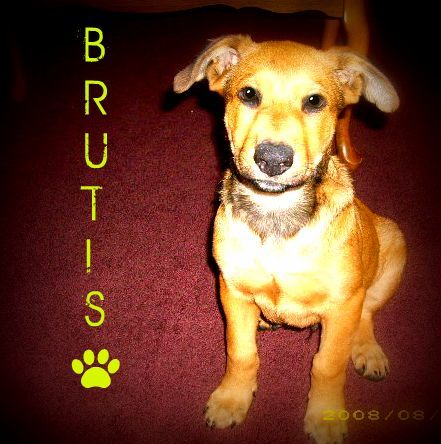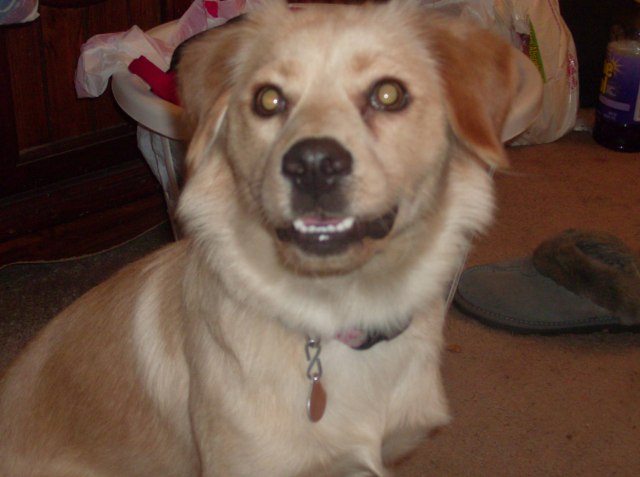QuestionI have a two month old female German Shepard Pitbull Mix. This is my first day with her and she is very timid, which is to be expected since its her first day. I want to know everything and anything about her breed. How to potty train, enact obedience, and train in general. I am unfamiliar with this type of dog, and any information provided, i will most certainly appreciate. I also have a two month old daughter, and i would like to know how to train my puppy with babies and children.
AnswerGreetings, and thank you for contacting All Experts!
Let's start by looking at your puppy's breed. Being a mixed breed, there are no characteristics set in stone, therefore you may see some traits of both the German Shepherd and the Pitbull breed. The main goal of breeding purebred dogs is to ''establish and maintain stable traits, that animals will pass to the next generation''. With mixed dogs, the guarantees of such ''stable traits'' is greatly lost, however there are some advantages to this. Purebred dogs are often prone to hereditary disorders. German Shepherds for instance, are prone to develop hip displaysia whereas Pitbulls may be prone to cataracts. Mixed breeds may at times bypass the development of such hereditary disorders, however there are no guarantees, and at times, mixed breeds may eventually develop hereditary disorders from both breeds.
Bruce Fogle, in his book '' Dog Owners' Manual'' claims that mixed breeds are less likely to develop inherited diseases because they benefit from hybrid vigor. What this means is that mixing stock from different genetic backgrounds may make dogs stronger. But as mentioned previously, mixed breeds may still carry to a certain extent genetic disorders deriving from the breeds that make up their genetics.
Now, from a temperament point of view let's see what traits you may likely see in your German Shepherd/pitbull mix. The American Kennel Club describes the German Shepherd breed as self-confident and equipped with a certain aloofness that does not lend itself to immediate and indiscriminate friendships. The breed needs exercise and mental stimulation. They are very intelligent and versatile. Shyness and weak nerves are a serious fault. You can read the standard here:
http://www.akc.org/breeds/german_shepherd_dog/
The United Kennel Club depicts the American pitbull terrier as a strong, confident dog with zest for life. They are extremely friendly towards humans so they do not typically make good guard dogs. However, their attitude towards other dogs is a different story. They are prone to exhibit some level of dog aggression. This may not be seen typically in a puppy, but generally develops as the dog reaches social maturity. The UKC pitbull standard is found here:
http://www.ukcdogs.com/WebSite.nsf/Breeds/AmericanPitBullTerrierRevisedNovember1
Both the German Shepherd and pitbull breed may be different, but they do have something in common: they require tons of training and loads of socialization. Puppies are particularly receptive up to the age of 16 weeks to absorbing everything that surrounds them. This is when socialization should be at peak levels. Ian Dunbar DVM, PhD claims puppies should be exposed to 100 new people by the age of 3 months. Here is my helpful guide on socializing a puppy:
http://adrienne-farricelli.suite101.com/how-and-when-to-socialize-puppies-a39401
You may also want to read this other guide which goes more in depth on the subject:
http://ahimsadogtraining.com/blog/puppy-training/
You may therefore want to make sure your puppy gets all its sets of shots and is exposed only to other healthy puppies. Puppy classes are highly recommended to grant ongoing socialization with people and other dogs. They are mostly once a week and often on week-ends or evenings.
Puppies as young as yours can already start learning some basic obedience components. ''Sit'' can be easily taught using a treat. This guide will show you how to train basic commands and also tackles important socialization basics that apply to your mixed puppy:
http://alexadry.hubpages.com/hub/How-to-Train-a-Pit-bull-Puppy
You may also want to implement a training method known as ''nothing in life is free''. This method which makes a dog earn its priviledges gives a purpose to working dogs and also helps shy dogs gain confidence. Here is a guide to this training method:
http://k9deb.com/nilif.htm
Potty training is something that will require some time, but if you follow some general rules, your puppy will catch on quickly. This guide covers important basics and strategies essential for getting a good start:
http://alexadry.hubpages.com/hub/How-to-Train-a-Pit-bull-Puppy
In regards to your two month daughter, it is great you have a puppy. It is much easier to have a puppy adapt to a baby than an adult dog. Your puppy should get used to her smell, crying, and movements fairly quickly. You will notice your puppy will grow very quickly, so it important your puppy learns how to act near the baby from the get-go. Make it clear from start that your baby is not a play-mate and that certain behaviors are not allowed. This goes both ways; teach your child as she grows that the puppy is not a toy. NEVER EVER, trust your puppy and your baby together alone, they should always be supervised. This guide is very helpful in applying safe interactions between puppies and toddlers;
http://www.diamondsintheruff.com/toddlersndogs.html
Puppies can be little biting machines and you want to refine your puppy's bite inhibition. Make sure you invest in good chewing toys suitable for puppies. While puppies learn some bite inhibition basics from being around their litter mates and mom, puppy owners will need to keep on working on this. Humans have a more sensitive skin than puppies, and therefore the puppy now must learn that not only he has to apply his bite inhibition with humans as well, but that he also needs to be even more kind. It therefore helps to apply the same life lessons its mom and litter mates applied in a similar way.
So let's say puppy comes near you and nips your hands, you will say a loud ''awrrp''! like it really hurt bad, and suddenly withdraw playing by turning your back to the puppy and become still as a statue. Make sure your ''awrrp'' is so loud and sudden that the puppy will remain surprised and startled stopping the behavior. When the puppy stops nipping, quickly give your puppy a toy to re-direct its nipping somewhere else, explains animal behaviorist Patricia McConnell. This will teach your dog that biting you is no fun and that the toy instead is. Repeat multiple times until your puppy grasps the concept.
If your puppy still engages in biting, then make the ''Awrrp'' noise and leave the room suddenly. Your puppy will soon learn that upon biting he loses his favorite playmate and it is no longer fun.
Some puppies can be rambunctious, and sometimes obnoxious in their behaviors. They need to be taught calmer behaviors and that upon acting rowdy all play and attention suddenly comes to a halt. A main problem encountered in nipping puppies is that upon nipping, the owners instinctively draw the hand back which in a puppy's mind this is an invitation to play. This often incites the puppy in more nipping and biting. Never encourage play with your hands.
I hope you are not overwhelmed; puppies can be a handful, but if you spend time on socializing them and training them they can give so much back! Just remember: your puppy may appear small and quite innocent at this stage, but puppies grow fast, so prevent bad habits from forming and encourage nice behaviors. The best place to start is by enrolling your puppy in puppy classes and providing ongoing training. This will make life much easier and your dog a better companion. Best wishes~ and kind regards!
Adrienne Janet Farricelli

 Shih tzu toilet training
Question
Shih Tzu Chihuahua
We have a Shihtzu/Chihuahua
Shih tzu toilet training
Question
Shih Tzu Chihuahua
We have a Shihtzu/Chihuahua
 Dog Training And Punishment?
Question
Maya
hi there i have an akita X husky,
Dog Training And Punishment?
Question
Maya
hi there i have an akita X husky,
 dog training.
Question
Brutis
I have a 6 month old german shepherd/la
dog training.
Question
Brutis
I have a 6 month old german shepherd/la
 Running/Non-Obeying
Question
Star
I have a female Lab mix who has this obse
Running/Non-Obeying
Question
Star
I have a female Lab mix who has this obse
 My mini-daschund is breaking ME in
Question
Tyson!
My miniature daschund is 8 months now,
My mini-daschund is breaking ME in
Question
Tyson!
My miniature daschund is 8 months now,